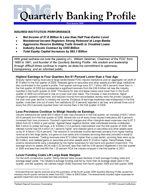1st Quarter Bank Earnings: Some good news, and some cautions
Industry returned to profitability, but down 61% from Q1 '08
- |
- Written by Steve Cocheo

quarter, with all classes of community banks registering sharper drops compared to past periods than did the largest institutions, FDIC reported in its first-quarter 2009 Quarterly Banking Profile report. (To see the video of the FDIC press conference, click here.)
Institutions with more than $10 billion in assets saw a decrease of 49%, whereas banks with less than $100 million in assets saw earnings fall by 61%. Those between $100 million and $1 billion saw earnings fall by 58%; and institutions in the $1 billion-$10 billion class actually posted a loss.
The $1 billion-$10 billion groups’ first-quarter loss marked its third quarterly loss in a row. This group also saw a loss for calendar 2008. That was the only category to do so for the whole year, in spite of the negative returns for all categories in 2008’s fourth quarter. Losses were reflected in these periods across both the commercial bank and savings institutions subsets of this size category.
More than one in five institutions (21.6%) reported net losses for the first quarter. Nearly three out of five institutions reported lower net income than in the first quarter of 2008.
Return on assets and return on equity ratios showed the same pattern as the basic earnings figures. Industrywide, ROA came to 0.22%, versus 0.59% for the first quarter of 2008. Similarly, ROE was 2.26% for the first quarter, versus 5.72% for the first quarter of 2008.
Causes for first-quarter troubles
Regarding the first quarter, FDIC blamed the poor performance on the following factors:
• High loan-loss provisions. The agency noted that provisions in the first quarter were lower than in the fourth quarter of last year, but that they were higher compared to the first quarter of 2008. Two out of three institutions increased their provisions for loan loss. The industry made $60.9 billion in loss provisions in the first quarter, a hike of 64% over the first quarter of 2008. Across the industry, the ratio of the loss allowance to loans and leases rose to 2.50%, versus 1.52% in the first quarter of last year. The ratio of the loss allowance to noncurrent loans and leases fell to 66.49%, versus 88.88%.
• Increased goodwill writedowns. FDIC reported that goodwill impairment charges and other intangible asset expenses shot up by 157%, to $7.2 billion from $2.8 billion in the first quarter 2008.
• Reduced income from securitizing loans. Net securitization income fell by 62%, comparing the first quarter 2009 to first quarter 2008.
These findings were cited for the industry as a whole, in FDIC’s official statements. Two other major issues came out in detail during the FDIC press conference on May 27, announcing the report’s release. These were a funding issue for community banks, and the issue of commercial real estate loan performance. Both are treated later in this report.
Working in the other direction, especially for larger banks, were two factors: realized gains on securities and other assets held, and sharply higher trading revenues.

In a formal statement, FDIC Chairman Sheila Bair expressed guarded optimism:
“First quarter results are telling us that the banking industry still faces tremendous challenges, and that going forward, asset quality remains a major concern. Banks are making good efforts to deal with the challenges they’re facing, but today’s report says that we’re not out of the woods yet. As I see it, we’re now in the cleanup phase for the banking industry. It will take some more time. But in the end, we’ll have a stronger banking industry that’s better able to meet the demand for credit as the economy recovers.”
FDIC Chief Economist Richard Brown noted that the recession is the longest since the 1930s and is clearly taking its toll on loan performance and therefore on the banking system.
In a separate statement issued after FDIC’s press conference, ABA Chief Economist James Chessen said:
“The earnings report released by the FDIC today demonstrates that banks are continuing to work through the problems presented by a difficult economy. Though first quarter earnings are down from what they were a year ago, they are the highest they have been in four quarters, and two out of every three banks increased their assets in the first quarter.” [Click here for the full text of Chessen’s statement.]
Community bank funding concerns
FDIC officials noted a significant issue in net interest margins for community banks. Indeed, the average net interest margin for institutions with less than $1 billion in assets fell to 3.56% from 3.66% in the fourth quarter, a 21-year low for that asset-size group.
For the industry as a whole, the quarterly net interest margin improved in the first quarter of 2009, coming in at 3.39%, from 3.34% in the fourth quarter of 2008 and 3.33% in the first quarter of 2008.
However, these industrywide figures are misleading.
“Most of the improvement was concentrated among larger institutions,” the FDIC report noted. Officials explained that larger banks typically have a stronger percentage of their funding from wholesale sources, which typically adjust more quickly than do the retail funding sources that represent the strongest source of community bank funding.
“Narrower margins have greater implications for the profitability of community banks,” FDIC stated. “They rely on retail deposits for two-thirds of their total funding.” The agency reported that more than half of institutions reported lower NIMs versus the first quarter of 2008, and that a full two-thirds of the industry reported lower NIMs versus the fourth quarter of 2008.
Credit trends continue to erode
Not surprisingly, in the current economy, institutions continue to see worsening credit trends. Insured institutions charged off $37.8 billion in bad loans in the first quarter, an increase of 93% over the first quarter of 2008.
More such chargeoffs may be in the offing. FDIC reported major increases in noncurrent loans, spanning the entire spectrum of major loan types.
“The high level of chargeoffs did not stem the growth in noncurrent loans in the first quarter,” the report observed. “On the contrary, noncurrent loans and leases increased by $59.2 billion (25.5%), the largest quarterly increase in the three years that noncurrent loans have been rising.”
FDIC reported that the rate of noncurrent loans now stands at its highest level since 1991.
Commercial real estate worries
FDIC officials reported that real estate loans accounted for 84% of the overall increase in nonperforming credit. Noncurrent closed-end 1-4 family residential mortgages rose by 28%; noncurrent real estate construction loans rose by 20.3%; and noncurrent loans secured by nonfarm nonresidential real estate rose by 40%. (The latter category is essentially a proxy for commercial real estate loans.)
Officials stated during the agency press conference that large numbers of institutions with commercial real estate loan exposures have high past-due rates in that part of their portfolios. Indications are that these rates have not yet reached their peaks.
Weakness in CRE lending “has not hit with full force, at this point,” said Richard Brown, the FDIC economist. John Corston, associate director for FDIC’s large institutions and analysis branch, predicted that the industry will see more trouble from CRE and construction lending in coming quarters, as the impact of a shrinking economy is felt more than it has been up until now.
A plus for residential real estate
By contrast, the FDIC officials speaking at the press meeting belief that the issues in residential real estate will taper off. “We’re pretty far through those portfolios already,” said Corston.
While there will be further losses in the residential area, Corston’s point was that recognition of loans that are troubled seems to be coming to an end. The bad eggs have all been marked, so to speak.
Tagged under Management, Financial Trends,
Related items
- How Banks Can Unlock Their Full Potential
- JP Morgan Drops Almost 5% After Disappointing Wall Street
- Banks Compromise NetZero Goals with Livestock Financing
- OakNorth’s Pre-Tax Profits Increase by 23% While Expanding Its Offering to The US
- Unlocking Digital Excellence: Lessons for Banking from eCommerce Titans













